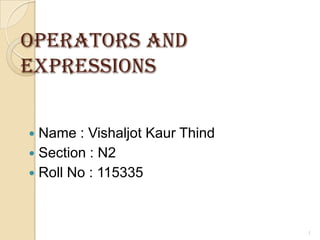
Operators and expressions
- 1. Operators and Expressions Name : Vishaljot Kaur Thind Section : N2 Roll No : 115335 1
- 2. Contents Objective Introduction Arithmetic operations Arithmetic expressions Relational operators Logical operators Assignment operators Increment and decrement operators Conditional operators Type conversions in expressions 2
- 3. Objectives ♥ To be able to construct and evaluate expressions. ♥ To master operator precedence and associativity ♥ To understand implicit type conversion and explicit type conversion. 3
- 4. 3.1 Introduction An operator is a symbol that tells the computer to perform certain manipulations. An expression is a sequence of operands and operators that reduces to a single value. C operators can be classified into a number of categories. ◦ Arithmetic operators ◦ Relational operators ◦ Logical operators ◦ Assignment operators ◦ Increment and decrement operators ◦ Conditional operators ◦ Bitwise operators ◦ Special operators 4
- 5. 5 3.2 Arithmetic operators The arithmetic operators in C Operator meaning + Addition or unary plus - Subtraction or unary minus * Multiplication / Division % modulo division
- 6. 6 3.2 Arithmetic operators Note:, ◦ Integer division truncates remainder ◦ The % operator cannot be applied to a float or double. ◦ The precedence of arithmetic operators Unary + or - * / % + -
- 7. 7 3.10 Arithmetic expressions An arithmetic expression is a combination of variables, constants, and operators. For example, a*b-c a*b-c (m+n)(x+y) (m+n)*(x+y) ax2+bx+c a*x*x+b*x+c
- 8. 8 3.3 Relational Operators • The relational operators in C are : Operator Meaning < less that <= less than or equal to > greater than >= greater than or equal to == equal to != not equal to
- 9. Relational Operators A relational expression yields a value of 1 or 0. ◦5<6 1 ◦ -34 + 8 > 23 - 5 0 ◦ if a=3, b=2, c =1; then a > b > c is ? the associativity of relational operators is left right 9
- 10. 3.4 Logical operators C has the following three logical operators ◦ && meaning logical and ◦ || meaning logical or ◦ ! meaning logical not ( unary operator ) Expressions connected by && or || are evaluated left to right, and evaluation stops as soon as the truth or falsehood of the result is known. 10
- 11. 3.5 Assignment operators The use of shorthand assignment operators has three advantages: ◦ 1. What appears on the left-hand side need not be repeated and therefore it becomes easier to write. ◦ 2. The statement is more concise and easier to read. ◦ 3. The statement is more efficient. 11
- 12. 3.6 Increment and decrement operators C provides two unusual operators for incrementing and decrementing variables. The increment operator ++ adds 1 to its operand, while the decrement operator -- subtracts 1. The unusual aspect is that ++ and -- may be used either as prefix operators (before the variable, as in ++n), or postfix operators (after the variable: n++). In both cases, the effect is to increment n. But the expression ++n increments n before its value is used, while n++ increments n after its value has been used. 12
- 13. The increment and decrement operators can be used in complex statements. Example: m=n++ -j +10; Consider the expression m = - n++ ; The precedence of ++ and – operators are the same as those of unary + and -. The associatively of them is right to left. m = - n++; is equivalent to m = - (n++) 13
- 14. 3.7 Conditional operator a ternary operator pair “? : ” is available in C to construct conditional expressions of the form expr1 ? expr2 : expr3 the expression expr1 is evaluated first. If it is non-zero (true), then the expression expr2 is evaluated, and that is the value of the conditional expression. Otherwise expr3 is evaluated, and that is the value. Only one of expr2 and expr3 is evaluated. 14
- 15. z = (a > b) ? a : b; /* z = max(a, b) */ 15
- 16. 3.9 Special operators 1. The Comma Operator The comma operator can be used to link the related expressions together. A comma-linked list of expressions is evaluated left to right and the value of right-most expression is the value of the combined expression. For example, the statement value = (x=10, y=5, x+y); first assigns the value 10 to x, then assigns 5 to y, and finally assigns 15 to value. Since comma operator has the lowest precedence of all operators, the parentheses are necessary. 16
- 17. 3.14 Type conversions in expressions 1. Implicit Type Conversion C permits mixing of constants and variables of different types in an expression. C automatically converts any intermediate values to the proper type so that the expression can be evaluated without loosing any significance. This automatic conversion is known as implicit type conversion. The rule of type conversion: the lower type is automatically converted to the higher type. 17
- 18. 3.13 Some Computational Problems When expressions include real values, then it is important to take necessary precautions to guard against certain computational errors. For example, consider the following statements: ◦ a = 1.0 / 3.0; ◦ b = a * 3.0; There is no guarantee that the value of b will equal 1. Another problem is division by zero. The third problem is to avoid overflow and underflow errors. 18
- 19. 3.15 Operator precedence and Associativity Rules of Precedence and Associativity ◦ (1)Precedence rules decides the order in which different operators are applied. ◦ (2)Associativity rule decide the order in which multiple occurrences of the same level operator are applied. Table3.8 on page71 shows the summary of C Operators. for example, a = i +1== j || k and 3 != x 19
- 20. THANKS 20